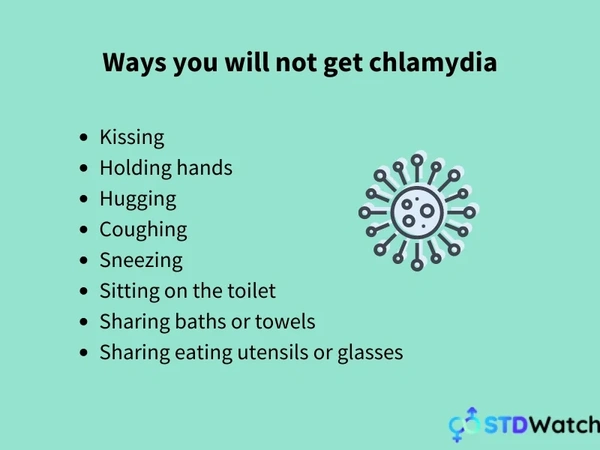- Medically reviewed by Dr. Andrea Pinto on 18 November 2021
By now, you probably know that unprotected sexual contact is the main method of transmission of many sexually transmitted diseases (STDs). Chlamydia is the most commonly reported STD in the United States, and the CDC estimates that there were approximately four million chlamydia infections in the United States during 2018.
Can you get chlamydia from kissing?
We all know that having unprotected sex is a risky activity that can lead to a sexually transmitted infection (STI) and that we should practice safe sex to prevent this. But it’s normal to worry about whether you can get an STI through more casual types of contact, such as kissing. The good news is that, as confirmed by Planned Parenthood, you can’t get chlamydia from casual contact, such as:
- Kissing
- Hugging
- Holding hands
- Coughing
- Sneezing
- Sitting on the toilet
- Sharing baths, towels, cutlery, or other utensils
According to Johns Hopkins All Children’s Hospital, it is possible to catch some STIs through kissing, so you should still be careful when it comes to choosing who to kiss. Some of the STIs that you can get from kissing include:
- Herpes
- Syphilis
- HIV
Get Tested For Chlamydia With LetsGetChecked Today!
What causes chlamydia?
So if you can’t get chlamydia from kissing, how does this disease spread? According to the NHS, there are several ways to get infected with chlamydia, including:
- Unprotected vaginal, anal, or oral sex
- Sharing sex toys without changing the condom or washing them between uses
- Genital-to-genital contact with an infected partner, even if there’s no penetration
- Getting infected semen, pre-seminal fluid (“precum”), or vaginal fluid in your eyes
- From mother to baby during pregnancy or childbirth
Chlamydia is just one out of several STDs that can be transmitted through oral sex, so it’s also very important to practice safe oral sex through the use of dental dams and condoms. According to the CDC, these STDs include:
- Chlamydia
- Gonorrhea
- Syphilis
- Herpes
- HPV
- HIV
- Trichomoniasis
Symptoms of chlamydia
Chlamydia is one of the most common STIs across the world, and it’s caused by a bacteria called Chlamydia trachomatis. According to the European Center for Disease Prevention and Control, approximately 70 percent of chlamydial infections in women and 50 percent in men are completely asymptomatic at the time of their diagnosis. This makes it hard to know exactly how many cases of chlamydia actually happen around the world, and it also facilitates its spread.
When chlamydia does cause symptoms, they will occur after the incubation period has ended. The incubation period for chlamydia can range between 7 and 21 days after the initial exposure to the bacteria.
According to the Cleveland Clinic, symptoms of chlamydia in females can include:
- White, yellow, or grayish vaginal discharge
- Increased urge to urinate
- Increased urinary frequency
- Painful or burning sensation when you urinate
- Pus in your urine
- Painful periods and/or intercourse
- Bleeding or spotting between your periods or after sex
- Itching or burning around your genitals
- Lower abdominal pain
Men, on the other hand, can experience symptoms that include:
- Clear discharge from the tip of your penis
- Painful or burning sensation when you urinate
- Painful, tender testicles
- Itching or burning sensation in your urethra
Both men and women can experience other symptoms if the infection enters the body through a different part of the body, such as the anus, throat, or eyes. These symptoms can include:
- Rectal pain and/or discharge
- Rectal bleeding
- A sore throat
- Eye redness, pain, and/or discharge
The bacteria that causes chlamydia, called Chlamydia trachomatis, can also cause a manifestation called lymphogranuloma venereum (LGV). According to StatPearls, this is an ulcerative disease that can be transmitted through vaginal, anal, and oral sex. Lymphogranuloma venereum develops in three distinct stages, which include:
- Primary stage: during this stage, painless ulcers or papules will develop at the site of infection.
- Secondary stage: unilateral or bilateral painful swelling of the lymph nodes located in the groin and/or pelvic area
- Third stage: this stage is also known as genitoanorectal syndrome, and it can cause deep tissue infections, abscesses, fibrosis, and fistulae of the urinary system, genitals, and/or anus.
Get Your LetsGetChecked Discount for Chlamydia Test Today!
Complications of chlamydia
If left untreated, chlamydia infections can lead to different long-term health complications — even in cases of asymptomatic chlamydia.
According to MedlinePlus, chlamydia can spread to other parts of the female reproductive tract, such as the uterus and the fallopian tubes. Over time, this can lead to different health problems, including:
- Pelvic inflammatory disease (PID)
- Pelvic pain
- Infertility
- Ectopic pregnancy
Male complications are rare, but in some cases, epididymitis can occur. Both men and women can also develop reactive arthritis from untreated chlamydia.
So — despite the fact that you can’t get chlamydia from kissing, this is still an STD that you need to watch out for. The good news is that chlamydia can be treated with simple antibiotic treatments. But since so many cases of chlamydia are asymptomatic, it’s important to get tested regularly so you can get the treatment you need and avoid passing the bacteria to more people. You can learn more about fast, affordable STD testing at STDWatch.com.
Get Your LetsGetChecked Discount for Chlamydia Test Today!
Resources
- Chlamydia – CDC Fact Sheet (Detailed) - cdc.gov
- Chlamydia - plannedparenthood.org
- Can You Get an STD From Kissing? - hopkinsallchildrens.org
- Chlamydia - nhs.uk
- STD Risk and Oral Sex - CDC Fact Sheet - cdc.gov
- Facts about chlamydia - ecdc.europa.eu
- Chlamydia - my.clevelandclinic.org
- Lymphogranuloma Venereum - ncbi.nlm.nih.gov



